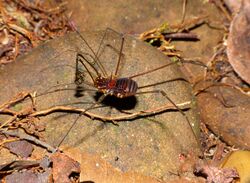Biology:Epedanidae
| Epedanidae | |
|---|---|

| |
| Unicorn harvestman (Epedanidae) | |
| Scientific classification | |
| Kingdom: | |
| Phylum: | |
| Class: | |
| Order: | |
| Suborder: | |
| Infraorder: | |
| Superfamily: | |
| Family: | Epedanidae Sørensen, in L. Koch 1886
|
| Genera | |
|
See text for list | |
| Diversity | |
| 70 genera, c. 200 species | |
Epedanidae is a family of the harvestman infraorder Grassatores with about 200 described species. They are the sister group of the Gonyleptoidea.[1]
The Epedanidae are endemic to Asia. The subfamily Dibuninae forms the predominant harvestman fauna of the Philippines . The other three subfamilies are more predominant in Indonesia, Malaysia and Thailand, and some are found in Burma and Nepal. Some species occur outside this region, in India , China , Vietnam and Japan .[1] One species is even endemic to New Guinea.[2] The oldest fossils of the family are known from the Cenomanian aged Burmese amber of Myanmar.[3]
Description
The body size ranges from two to five millimeters, with thin legs ranging from six to 26 mm. The chelicerae are heavy with strong teeth in both fingers. The pedipalps are long and strong, with powerful spines lining the inside of the claw. Most species are light brown with few black mottling. Some species possess white patches on the scutum. The pedipalps are much more heavily spined in males, together with a swollen cheliceral hand.[1]
Name
The type genus Epedanus is derived from Ancient Greek epedanos "weak, feeble".
Genera
For a list of all currently described species see List of Epedanidae species.
Dibuninae Roewer, 1912
- Dibunus Loman, 1906
Epedaninae Sørensen, in L. Koch 1886
- Alloepedanus S. Suzuki, 1985
- Balabanus Suzuki, 1977
- Caletorellus Roewer, 1938
- Epedanellus Roewer, 1911
- Epedanidus Roewer, 1945
- Epedanulus Roewer, 1913
- Epedanus Thorell, 1876
- Euepedanus Roewer, 1915
- Funkikoa Roewer, 1927
- Heteroepedanus Roewer, 1912
- Aboriscus Roewer, 1940
- Lobonychium Roewer, 1938
- Metathyreotus Roewer, 1913
- Metepedanulus Roewer, 1913
- Metepedanus Roewer, 1912
- Mosfora Roewer, 1938
- Nanepedanus Roewer, 1938
- Neoepedanus Roewer, 1912
- Paratakaoia S. Suzuki, 1985
- Parepedanulus Roewer, 1913
- Plistobunus Pocock, 1903
- Pseudoepedanus Suzuki, 1969
- Pseudomarthana P. D. Hillyard, 1985
- Takaoia Roewer, 1911
- Thyreotus Thorell, 1889
- Toccolus Roewer, 1927
- Zepedanulus Roewer, 1927
Acrobuninae Roewer, 1912
- Acrobunus Thorell, 1891
- Anacrobunus Roewer, 1927
- Harpagonellus Roewer, 1927
- Heterobiantes Roewer, 1912
- Metacrobunus Roewer, 1915
- Paracrobunus Suzuki, 1977
Sarasinicinae Roewer, 1923
- Acanthepedanus Roewer, 1912
- Albertops Roewer, 1938
- Asopella Sørensen, 1932
- Delicola Roewer, 1938
- Gintingius Roewer, 1938
- Kilungius Roewer, 1915
- Koyanus Roewer, 1938
- Kuchingius Roewer, 1927
- Nobeoka Roewer, 1938
- Opelytus Roewer, 1927
- Padangcola Roewer, 1963
- Panticola Roewer, 1938
- Parepedanus Roewer, 1912
- Pasohnus Suzuki, 1976
- Pseudobiantes Hirst, 1911
- Punanus Roewer, 1938
- Sarasinica Strand, 1914
- Sembilanus Roewer, 1938
- Sinistus Roewer, 1938
- Siponnus Roewer, 1927
- Sungsotia Tsurusaki, 1995
- Tegestria Roewer, 1936
- Tonkinatus Roewer, 1938
- Beloniscellus Roewer, 1912
- Beloniscops Roewer, 1949
- Belonisculus Roewer, 1923
- Beloniscus Thorell, 1891
- Buparellus Roewer, 1949
- Bupares Thorell, 1889
- Dhaulagirius Martens, 1977
- Dumaguetes Roewer, 1927
- Parabeloniscus Suzuki, 1967
- Parabupares S. Suzuki, 1982
- Sotekia S. Suzuki, 1982
- Tithaeus Thorell, 1890
- Tokunosia Suzuki, 1964
- †Petrobunoides Selden et al. 2016 Burmese amber, Myanmar, Cenomanian
- †Biungulus Bartel et al, 2020 Burmese amber, Myanmar, Cenomanian
- †Gigantocheles Bartel et al, 2020 Burmese amber, Myanmar, Cenomanian
Footnotes
- ↑ 1.0 1.1 1.2 Kury, Adriano B. (2007): Epedanidae. Sørensen, 1886. In: Pinto-da-Rocha et al. 2007: 188.
- ↑ Hallan Biology Catalog
- ↑ Selden, Paul A.; Dunlop, Jason A.; Giribet, Gonzalo; Zhang, Weiwei; Ren, Dong (October 2016). "The oldest armoured harvestman (Arachnida: Opiliones: Laniatores), from Upper Cretaceous Myanmar amber". Cretaceous Research 65: 206–212. doi:10.1016/j.cretres.2016.05.004. ISSN 0195-6671. http://dx.doi.org/10.1016/j.cretres.2016.05.004.
References
- Joel Hallan's Biology Catalog: Epedanidae
- Pinto-da-Rocha, R., Machado, G. & Giribet, G. (eds.) (2007): Harvestmen - The Biology of Opiliones. Harvard University Press ISBN:0-674-02343-9
Wikidata ☰ Q3055683 entry
 |

